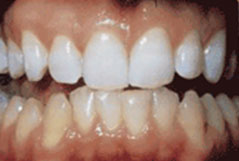Email Replying
Aesthetic Dentistry
Aesthetic dentistry can be described as one or more dental treatments which improve the beauty of your smile. A beautiful, more alluring smile can be the beginning of a more successful life for you. Aesthetic dentistry can include a variety of techniques from re-contouring the teeth and gums to placing veneers on a number of teeth.
Inlays,Onlays
When a tooth has lost a significant amount of its structure one of the options for treatment can be an inlay or onlay. An inlay fits into the tooth whilst an onlay also covers the top biting surface of the tooth. Both inlays and onlays are usually manufactured in a dental laboratory using precision models of your teeth and are used when a dentist thinks a direct filling will not offer enough protection to the tooth for the long term.
The Inlay or Onlay Process.
Your dentist will evaluate your tooth first to ensure that the tooth is alive and the remaining tooth tissue is healthy enough for your inlay or onlay. Your dentist will also ensure that you have enough tooth tissue left so that an inlay or onlay restores your tooth's looks and function for many years to come.
The stages for having an inlay or onlay are usually as follows:
1. Evaluation of the tooth
Your dentist ensures that an inlay or onlay is the best treatment for your tooth. Tests including a dental x-ray will be used to ensure that as much information on the health and vitality of the tooth is available before a treatment decision is made.
2. Tooth Preparation
Dependant on the type of inlay or onlay, your dentist prepares a very smooth walled cavity in your tooth to allow the inlay or onlay to fit well. Your dentist preserves as much of your natural tooth substance as possible during this preparation phase.
3. Impression taking
Your dentist usually takes precision impressions of your teeth so that models can be made to allow the dental technician to construct your inlay or onlay.
4. Fitting
Your dentist tries your inlay or onlay on to ensure it fits correctly, looks excellent and is in harmony with your bite. Once you are totally happy a permanent adhesive system is used to bond your inlay or onlay to the tooth.
Tooth Whitening
|
Tooth whitening is a simple, safe, and effective method of creating a whiter and brighter smile. Years of staining from coffee, tea, red wine and tobacco and food products can disappear using a tooth whitening treatment. Results can be seen instantly using our laser tooth whitening system or, if you prefer a tooth whitening take home solution, results can be seen in just a couple of weeks. |
 |
Types of Tooth Whitening
1. In-Office bleaching
We use the solution that is in Hydrogen peroxide or Carbamide peroxide which be highly strong approximately 15-50%. It is operated by Blue Light, Cool Light, and laser for activate the solution. Then, there is a process for protect tissue around teeth to avoid irritation. Bleacing process takes 1-3 hours per times. What's more, you can trust that our teeth whitening treatments have been extensively evaluated to provide a safe and proven way to lighten the shade of your smile.
2. Home–bleaching
Home teeth bleaching systems allow you to whiten your teeth from the comfort of your own home, but you should not attempt to use one without expert advice.
Tray based teeth bleaching treatments can provide the ideal home whitening solution, depending on the level of tooth discolouration. Choose a home teeth whitening programme designed specifically for you.
3. Over the counter bleaching
Similar to Home-Bleaching but packaging is including กisposable tray which coated with bleaching solution. So that, this kind is still not concluding the result and side effects.
 |
 |
|
Before
|
After
|
 |
 |
|
Before
|
After
|
Dental Veneer

Dental veneers are the true symbol of the 21st century celebrity lifestyle. From Hollywood actresses to television personalities, dental veneers have changed the smiles of many a dazzling celebrity.
Dental veneers aren't just for the rich and famous, however. We want to make dental veneers available to you - which is why we want to separate the truth from the hype and fill you in on how dental veneers really work.
Different types of Dental Veneers for different purposes
All dental veneers have the following in common:
- Dental veneers utilize a tooth colored material to cover over the visible portion of the tooth. This is usually a very thin layer which can be compared with a false finger nail, although massively stronger and more technical to place on the tooth
- Veneers rely on special dental adhesive technology for their strength
- Good color matching and excellent construction helps veneers achieve a superior, lifelike result that will last for the long term.
Porcelain Veneers
For many years porcelain veneers have been the most commonly provided type of veneer in the UK. Veneers made from porcelain can be used to change the shade, shape, position or size of teeth and also to close or reduce gaps between teeth.
Traditional porcelain veneers are constructed in a dental laboratory from precision models of your teeth made from impressions that your dentist takes as part of your treatment.
For traditional porcelain veneers it is very common to require some preparation of the underlying tooth to create space to place the veneer. In certain cases such as where a tooth is being brought forward into the line of the arch or where a small tooth is being made bigger, no preparation may be required.
Composite Veneers
Dental composite veneers are made using the same type of materials that are used for cosmetic bonding and for many white fillings. Composite veneers are most often provided directly by your dentist at a single visit where the composite is applied to your tooth surface and polished to create the veneer surface.
Occasionally composite can be used by your dental laboratory to make veneers which are then fitted by your dentist at a second visit. Composite is not as hard wearing in the longer term as porcelain and so you can expect to require your composite veneers replacing after five or six years on average. Many porcelain veneers are still serviceable after 14 or 15 years.

